November is Picture Book Month, and it’s the perfect time to celebrate that books in picture book format are for everyone. The picture book biographies reviewed this week introduce readers of all ages to creative individuals who have made contributions in the visual, literary, and performing arts. These books make great read-alouds for students at different grade levels to spark interest and discussion in a topic and to pair with related books and works in other media.
Big Machines: The Story of Virginia Lee Burton. Sherri Duskey Rinker. Ill. John Rocco. 2017. Houghton Mifflin Harcourt.
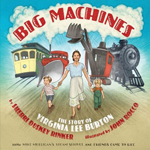 Big Machines is both a biography of children’s book author and illustrator Virginia Lee Burton (1909–1968) and an introduction to the stories she created for her sons about “the things they loved best: BIG MACHINES.”. Rinker and Rocco’s telling of Burton’s creation of the adventures of Choo Choo (train), Mary Anne (steam shovel), Katy (snow plow), and Maybelle (cable car) is the perfect companion to Burton’s books about these big machines and The Little House 75th anniversary Edition.
Big Machines is both a biography of children’s book author and illustrator Virginia Lee Burton (1909–1968) and an introduction to the stories she created for her sons about “the things they loved best: BIG MACHINES.”. Rinker and Rocco’s telling of Burton’s creation of the adventures of Choo Choo (train), Mary Anne (steam shovel), Katy (snow plow), and Maybelle (cable car) is the perfect companion to Burton’s books about these big machines and The Little House 75th anniversary Edition.
—CA
A Boy, a Mouse, and a Spider: The Story of E. B. White. Barbara Herkert. Ill. Lauren Castillo. 2017. Christy Ottaviano/Henry Holt.
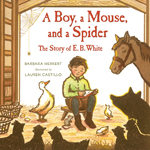 “E. B. White / celebrated life through / a mouse’s journey, / the pact between a pig and a spider, / and the power of words.” Herkert’s poetic text, complemented by Castillo’s warm ink-and-watercolor illustrations, expresses beloved author E. B. White’s love of animals and words. After a career writing for various newspapers and The New Yorker, White made a farm in Maine his home. It was there that he wrote his first two children’s book featured in the biography, Stuart Little (1945) and Charlotte’s Web (1952). An author’s note about the life of Elwyn Brooks White (1899–1985) includes a mention of White’s revision of William Strunk Jr.’s book on writing well, The Elements of Style, in 1957 andhis third children’s book, The Trumpet of the Swan (1968).
“E. B. White / celebrated life through / a mouse’s journey, / the pact between a pig and a spider, / and the power of words.” Herkert’s poetic text, complemented by Castillo’s warm ink-and-watercolor illustrations, expresses beloved author E. B. White’s love of animals and words. After a career writing for various newspapers and The New Yorker, White made a farm in Maine his home. It was there that he wrote his first two children’s book featured in the biography, Stuart Little (1945) and Charlotte’s Web (1952). An author’s note about the life of Elwyn Brooks White (1899–1985) includes a mention of White’s revision of William Strunk Jr.’s book on writing well, The Elements of Style, in 1957 andhis third children’s book, The Trumpet of the Swan (1968).
—CA
Danza!: Amalia Hernández and El Ballet Folklórico México. Duncan Tonatiuh. 2017. Abrams.
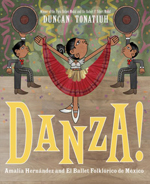 Enthralled with the dancing she saw on the streets of Mexico City as a child, Amalia Hernández (1917–2000) convinced her parents to support her study of ballet and modern dance. As a choreographer and dance teacher, Hernández created dances inspired by the traditional folk dances of Mexico. Tonatiuh’s signature Mixtec-inspired illustrations depict graceful, energetic, and colorful folklórico performances, representing traditions of celebration and community. The dance company Hernández founded in 1952 grew and was celebrated in her homeland and globally. The back matter includes a glossary of Spanish terms, bibliography, and an author’s note.
Enthralled with the dancing she saw on the streets of Mexico City as a child, Amalia Hernández (1917–2000) convinced her parents to support her study of ballet and modern dance. As a choreographer and dance teacher, Hernández created dances inspired by the traditional folk dances of Mexico. Tonatiuh’s signature Mixtec-inspired illustrations depict graceful, energetic, and colorful folklórico performances, representing traditions of celebration and community. The dance company Hernández founded in 1952 grew and was celebrated in her homeland and globally. The back matter includes a glossary of Spanish terms, bibliography, and an author’s note.
—SW
Frida Kahlo and Her Animalitos. Monica Brown. Ill. John Parra. 2017. NorthSouth.
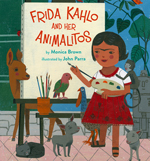 Brown and Parra’s colorful child-friendly biography of Frida Kahlo (1907–1954) focuses on the relationship between the famous Mexican artist and her animalitos (monkeys, parrot, dogs, turkeys, cat, and many others), which were her companions in her childhood home, La Casa Azul, and throughout her life. Although she was always in poor health due to illnesses and a serious accident, she created hundreds of folk art paintings influenced by Mexican culture, including more than fifty self-portraits, many of which include her animalitos. The author’s note contains a selected list of Kahlo’s paintings that feature her pets.
Brown and Parra’s colorful child-friendly biography of Frida Kahlo (1907–1954) focuses on the relationship between the famous Mexican artist and her animalitos (monkeys, parrot, dogs, turkeys, cat, and many others), which were her companions in her childhood home, La Casa Azul, and throughout her life. Although she was always in poor health due to illnesses and a serious accident, she created hundreds of folk art paintings influenced by Mexican culture, including more than fifty self-portraits, many of which include her animalitos. The author’s note contains a selected list of Kahlo’s paintings that feature her pets.
—CA
Imagine That!: How Dr. Seuss Wrote The Cat in the Hat. Judy Sierra. Ill. Kevin Hawkes. 2017. Random House.
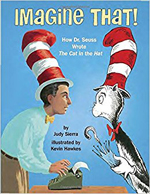 In 1954, Theodor Geisel (Dr. Seuss) was asked to write a book that would help children enjoy reading as they learned to read. Thinking the task would not take long, he soon discovered he had to rethink everything he knew about writing a story. Sierra’s engaging text and Hawkes’s illustrations, which combine Dr. Seuss’s whimsical drawings and paintings of the famed author at work, show Geisel’s processes of creating a first-grade reader that incorporated a “No-Nonsense List” of simple words. Lines such as “I will draw two nice kids to have fun with the cat, / And two naughty Things, and a keen cleaner-upper” reflect his clever language. The back matter includes tips on writing and illustrating from Dr. Seuss, notes from the author and the illustrator, and a list of books by written and illustrated by Dr. Seuss.
In 1954, Theodor Geisel (Dr. Seuss) was asked to write a book that would help children enjoy reading as they learned to read. Thinking the task would not take long, he soon discovered he had to rethink everything he knew about writing a story. Sierra’s engaging text and Hawkes’s illustrations, which combine Dr. Seuss’s whimsical drawings and paintings of the famed author at work, show Geisel’s processes of creating a first-grade reader that incorporated a “No-Nonsense List” of simple words. Lines such as “I will draw two nice kids to have fun with the cat, / And two naughty Things, and a keen cleaner-upper” reflect his clever language. The back matter includes tips on writing and illustrating from Dr. Seuss, notes from the author and the illustrator, and a list of books by written and illustrated by Dr. Seuss.
—SW
John Ronald’s Dragons: The Story of J. R. R. Tolkien. Caroline McAlister. Ill. Eliza Wheeler. 2017. Roaring Brook.
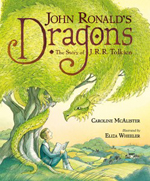 Living in the English midlands, the young John Ronald loved trees, words, and—above all—fairy-tale dragons. When his mother died, he and his brother went to live with their distant, cold aunt, he longed for dragons, but his life as a student at school, and later at university, came first. After World War I, as a professor of Anglo-Saxon at Oxford, he had the idea for The Hobbit and told his four children stories of Bilbo Baggins. Wheeler’s fanciful illustrations depicting moments in Tolkien’s life show how he created Smaug, the dragon who first appeared in The Hobbit. The back matter includes McAlister’s extensive note about her writing process and Wheeler’s illustrator’s note, which explains references in the illustrations.
Living in the English midlands, the young John Ronald loved trees, words, and—above all—fairy-tale dragons. When his mother died, he and his brother went to live with their distant, cold aunt, he longed for dragons, but his life as a student at school, and later at university, came first. After World War I, as a professor of Anglo-Saxon at Oxford, he had the idea for The Hobbit and told his four children stories of Bilbo Baggins. Wheeler’s fanciful illustrations depicting moments in Tolkien’s life show how he created Smaug, the dragon who first appeared in The Hobbit. The back matter includes McAlister’s extensive note about her writing process and Wheeler’s illustrator’s note, which explains references in the illustrations.
—SW
Mama Africa!: How Miriam Makeba Spread Hope with Her Song. Kathryn Erskine. Ill. Charly Palmer. 2017. Farrar Straus Giroux.
 Miriam Makeba (1932–2008) grew up feeling free in her singing, but not free in her homeland of South Africa, where she and all nonwhite people lived in increasingly oppressive conditions of apartheid. Encouraged by singers such as Ella Fitzgerald and Billie Holiday, she sang songs of protest in other African languages to disguise the lyrics. Bright paintings depict her powerful voice, while somber hues depict the oppressive conditions of nonwhite people living in danger of being imprisoned in South Africa. Having left the country in 1959, Makeba was forbidden to return and began a thirty-year campaign to draw global attention to apartheid. The back matter includes an author’s note about her life in South Africa, a timeline of Makeba’s life along with events of the U.S. Civil Rights Movement, a bibliography, suggestions for further reading, and a glossary.
Miriam Makeba (1932–2008) grew up feeling free in her singing, but not free in her homeland of South Africa, where she and all nonwhite people lived in increasingly oppressive conditions of apartheid. Encouraged by singers such as Ella Fitzgerald and Billie Holiday, she sang songs of protest in other African languages to disguise the lyrics. Bright paintings depict her powerful voice, while somber hues depict the oppressive conditions of nonwhite people living in danger of being imprisoned in South Africa. Having left the country in 1959, Makeba was forbidden to return and began a thirty-year campaign to draw global attention to apartheid. The back matter includes an author’s note about her life in South Africa, a timeline of Makeba’s life along with events of the U.S. Civil Rights Movement, a bibliography, suggestions for further reading, and a glossary.
—SW
Muddy: The Story of Blues Legend Muddy Waters. Michael Mahin. Ill. Evan Turk. 2017. Atheneum/Simon & Schuster.
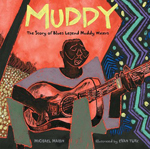 “But Muddy was never good at doing what he was told” is a refrain that runs throughout the blues-infused lyrical text of this picture book biography of McKinley Morganfield (1913–1983), who became Muddy Waters, the blues legend who left his childhood home in Mississippi and went north to Chicago. Even though his style of music didn’t fit in with “the bebop jazzing swing of horns and strings” popular in the clubs, Muddy, “never good at doing what he was told,” continued to play his own kind of music. Persistence paid off, and Muddy’s blend of traditional Mississippi Delta blues and jazz became the basis for the Chicago blues. Turk’s energetic, boldly colored mixed-media artwork gives Muddy’s story visual expression. Back matter includes an author’s note, bibliography, and a suggested list of collections of the “best of Muddy Waters” for listening.
“But Muddy was never good at doing what he was told” is a refrain that runs throughout the blues-infused lyrical text of this picture book biography of McKinley Morganfield (1913–1983), who became Muddy Waters, the blues legend who left his childhood home in Mississippi and went north to Chicago. Even though his style of music didn’t fit in with “the bebop jazzing swing of horns and strings” popular in the clubs, Muddy, “never good at doing what he was told,” continued to play his own kind of music. Persistence paid off, and Muddy’s blend of traditional Mississippi Delta blues and jazz became the basis for the Chicago blues. Turk’s energetic, boldly colored mixed-media artwork gives Muddy’s story visual expression. Back matter includes an author’s note, bibliography, and a suggested list of collections of the “best of Muddy Waters” for listening.
—CA
The Music of Life: Bartolomeo Cristofori & the Invention of the Piano. Elizabeth Rusch. Ill. Marjorie Priceman. 2017. Atheneum/Simon & Schuster.
 The Music of Life tells two stories, one about Cristofori, an Italian builder of harpsichords, and one of his invention, the pianoforte: a musical instrument that combined the loudness of the harpsichord and the soft sound of the clavichord. Prince Ferdinand de Medici of Florence, a musician and patron of the arts, retained Cristofori to repair and build harpsichords and clavichords. Rusch’s integration of primary and secondary sources in the text gives a sense of the culture in which Cristofori worked, and the integration of the language of music—pianissimo (softest) and crescendo (becoming louder)—in Priceman’s lively gouache-and-ink illustrations convey the meaning of each double spread of this beautifully-crafted picture book. The extensive back matter includes an author’s note detailing Rusch’s writing process and notes on the history of the pianoforte and the modern piano.
The Music of Life tells two stories, one about Cristofori, an Italian builder of harpsichords, and one of his invention, the pianoforte: a musical instrument that combined the loudness of the harpsichord and the soft sound of the clavichord. Prince Ferdinand de Medici of Florence, a musician and patron of the arts, retained Cristofori to repair and build harpsichords and clavichords. Rusch’s integration of primary and secondary sources in the text gives a sense of the culture in which Cristofori worked, and the integration of the language of music—pianissimo (softest) and crescendo (becoming louder)—in Priceman’s lively gouache-and-ink illustrations convey the meaning of each double spread of this beautifully-crafted picture book. The extensive back matter includes an author’s note detailing Rusch’s writing process and notes on the history of the pianoforte and the modern piano.
—SW
Silent Days, Silent Dreams. Allen Say. 2017. Scholastic.
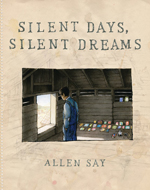 Silent Days, Silent Dreams is a tribute to James Castle (1899–1977), American artist, born into a poor Idaho farm family, who was deaf and never learned to speak. In his silent and solitary lifetime, Castle created thousands of pieces of art. Say’s extensive author’s note details how he was introduced to the work of Castle, learned more about his life, and came to create this book in which he emulated the artist’s style in many of the illustrations, using the same kind of materials that Castle did— burnt matchsticks, soot mixed with spit, shoe polish, and laundry bluing—to make drawings on used grocery bags and scraps of paper. The result is what Say describes as “an imagined biography of a most original and enigmatic artist, whose fame continues to grow.”
Silent Days, Silent Dreams is a tribute to James Castle (1899–1977), American artist, born into a poor Idaho farm family, who was deaf and never learned to speak. In his silent and solitary lifetime, Castle created thousands of pieces of art. Say’s extensive author’s note details how he was introduced to the work of Castle, learned more about his life, and came to create this book in which he emulated the artist’s style in many of the illustrations, using the same kind of materials that Castle did— burnt matchsticks, soot mixed with spit, shoe polish, and laundry bluing—to make drawings on used grocery bags and scraps of paper. The result is what Say describes as “an imagined biography of a most original and enigmatic artist, whose fame continues to grow.”
—CA
Vincent Can’t Sleep: Van Gogh Paints the Night Sky. Barb Rosenstock. Ill. Mary GrandPré. 2017. Alfred A. Knopf/Random House.
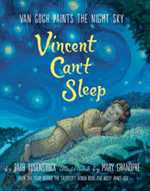 A lyrical text accompanied by stunning illustrations, rendered in acrylic, pen, and watercolor, chronicle the life of Vincent Van Gogh (1853–1890), “A sensitive boy. / A hidden genius. / A brilliant artist.” Throughout his life, insomnia led to his wanderings and contemplation of the nature of the nighttime sky. One year before his death, Van Gogh created “The Starry Night,” which captures the colors, textures, and rhythm of the darkness of night that he perceived. Back matter includes an author’s note and photographs of his famous paintings.
A lyrical text accompanied by stunning illustrations, rendered in acrylic, pen, and watercolor, chronicle the life of Vincent Van Gogh (1853–1890), “A sensitive boy. / A hidden genius. / A brilliant artist.” Throughout his life, insomnia led to his wanderings and contemplation of the nature of the nighttime sky. One year before his death, Van Gogh created “The Starry Night,” which captures the colors, textures, and rhythm of the darkness of night that he perceived. Back matter includes an author’s note and photographs of his famous paintings.
—CA
Sandip LeeAnne Wilson serves as professor in the School of Education and the English Department of Husson University, Bangor, Maine. Carolyn Angus is former Director of the George G. Stone Center for Children's Books, Claremont Graduate University, in Claremont, California